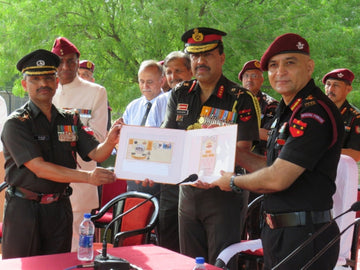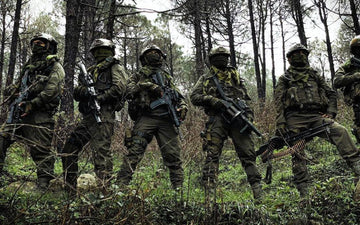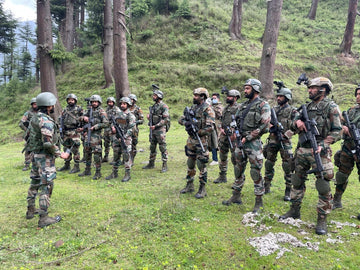The 10 Para Special Forces (10 Para SF), also known as the "Desert Scorpions," is one of the most elite and battle-hardened units of the Indian Army’s Parachute Regiment. Specializing in desert warfare, counter-insurgency, and counter-terrorism, this unit has earned a formidable reputation for its precision, resilience, and ability to execute high-risk missions with unparalleled efficiency. Raised on June 1, 1967, the 10 Para SF has a storied history of valor, with its operatives embodying the motto “Shatrujeet” (Conqueror of Enemies). This article delves into the history, roles, training, key operations, and unique aspects of the 10 Para SF, offering a comprehensive overview of this elite force.
History and Formation
The origins of the 10 Para SF can be traced back to the aftermath of the 1965 Indo-Pakistani War, which highlighted the need for specialized commando units capable of conducting covert operations behind enemy lines. The Meghdoot Force, an impromptu commando unit formed during the war, served as the precursor to the Indian Army’s permanent special forces. In July 1966, the 9th Parachute Commando Battalion (now 9 Para SF) was established as the first special operations unit under the Parachute Regiment. A year later, in June 1967, the unit was split to form a sister unit, the 10th Parachute Commando Battalion, which became the 10 Para SF.

The 10 Para SF was specifically mandated to operate in the Western Desert, covering regions from the lower border of Punjab to Gujarat, with a focus on desert warfare. Over time, the unit expanded its expertise to include urban, jungle, and mountain warfare, making it a versatile force capable of operating in diverse terrains. Its nickname, “Desert Scorpions,” reflects its mastery of operations in arid environments and its ability to strike swiftly and decisively.
Roles and Responsibilities
The 10 Para SF is tasked with a wide array of high-risk missions, reflecting its status as a Tier 1 special forces unit within the Indian Army. Its primary roles include:
- Desert Warfare: Specializing in operations in arid and desert environments, the unit is trained to navigate and survive in harsh conditions, including sand dunes and extreme temperatures.
- Counter-Insurgency and Counter-Terrorism: The 10 Para SF is extensively involved in counter-insurgency operations, particularly in Jammu and Kashmir, where it conducts raids, ambushes, and covert missions against terrorist groups.
- Direct Action: The unit undertakes precision strikes to neutralize high-value targets, including enemy personnel, infrastructure, and communication networks.
- Special Reconnaissance: Gathering intelligence behind enemy lines is a critical function, enabling strategic decision-making for larger military operations.
- Hostage Rescue and Unconventional Warfare: The unit is trained for hostage rescue operations and unconventional warfare, including sabotage and disruption of enemy operations.
- Foreign Internal Defence: The 10 Para SF participates in training and supporting friendly foreign forces, enhancing their capabilities through joint exercises.
The unit operates in small, highly cohesive teams of five or six commandos, each trained in multiple disciplines such as weapons handling, communications, navigation, medical skills, and demolitions. This ensures no dependency on a single individual during missions, enhancing operational flexibility.

Training and Selection
The selection process for the 10 Para SF is among the most grueling in the world, with a dropout rate of 90-95%. Only the most physically and mentally resilient candidates make it through the rigorous training pipeline.
Selection Process
- Basic Military Training: Candidates must first join the Indian Army and complete basic training, which varies by training center and role.
- Pre-Selection: This phase involves administrative procedures, medical evaluations, and an application to join either the Para (Airborne) or Para (SF).
- Basic Parachute Course: Candidates undergo a three-week Basic Parachute Course at the Paratrooper Training School in Agra to qualify as paratroopers.
- Para SF Probation: The 90-day probation period for 10 Para SF is conducted in desert conditions and includes extreme physical and mental tests. Candidates carry a 10 kg sandbag and full battle gear during speed marches and runs of 10 km, 20 km, 30 km, and 40 km. They must navigate without landmarks, survive with minimal water (1 liter for three days), and go without sleep for up to seven days.
Key Training Phases
- 100 km Endurance Run: Probationers must complete a 100 km run with a 10 kg battle load and a 7 kg personal weapon in 13-15 hours, often along challenging routes like Rampur to Dakkal.
- 36-Hour Stress Test: This phase tests endurance with a 10 km speed march carrying a 30 kg battle load, followed by exercises like lifting teammates, shifting heavy weights (e.g., 85 kg logs or 40-liter jerry cans), and simulated drowning to assess panic reactions under stress.
- Counter-Terrorism Operations Phase: The final 30 days involve classified tasks, testing candidates’ ability to handle real-world scenarios.
- Specialized Training: After probation, operatives undergo advanced training at the Special Forces Training Centre in Nahan, covering weapons, communications, navigation, medical skills, and demolitions. They also train in combat freefall (HALO/HAHO), combat diving, and close-quarter battle (CQB).
Successful candidates earn the coveted maroon beret and participate in the unique glass-eating ritual, symbolizing fearlessness and superiority. The Balidan Badge, signifying battlefield sacrifices, is awarded after a candidate’s first successful operation.
Key Operations
The 10 Para SF has a distinguished record of operations, showcasing its operational prowess and strategic importance. Some notable missions include:
- Chachro Raid (1971): During the 1971 Indo-Pakistani War, under the leadership of Lt. Col. Swai Bhawani Singh (Maharaja of Jaipur), the 10 Para SF executed one of the most successful commando operations in history. After six months of preparation, the unit captured the towns of Chachro, Virawah, Nagarparkar, Islamkot, and Lunio without a single casualty, neutralizing 36 enemy personnel and taking 22 prisoners of war. This operation is studied by special forces worldwide, including the US and UK’s SAS.
- Operation Pawan (1987): The 10 Para SF participated in the Indian Peace Keeping Force (IPKF) operations in Sri Lanka against the LTTE. Despite challenges, such as the failed heli-borne assault on Jaffna University, the unit’s efforts contributed to capturing the Jaffna peninsula. The LTTE feared the 10 Para SF, particularly under the command of Col. Dalvir Singh, known as the “Saint Soldier.”
- Kargil War (1999): The 10 Para SF was among the first units deployed in the Kargil hills, gathering critical intelligence on the scale of Pakistani intrusion. Their covert operations and raids were instrumental in supporting larger military efforts.
- World Special Forces Competitions (2002, 2004): In 2002, a small team from 10 Para SF, led by Capt. Virendra Salaria and Capt. TR Krishna Das, won a global special forces competition, defeating elite units from the US, UK, France, and Russia. In 2004, they secured a silver medal, showcasing their global standing.
- Covert Operation in Jammu and Kashmir: In a notable covert mission, Major Sangram Singh and Captain Vikas of 10 Para SF disguised themselves as militants and infiltrated an LeT camp in Jammu and Kashmir. They gathered critical intelligence over four days, eliminated four terrorists, and disrupted the LeT network in the region.
Unique Aspects and Traditions
- Nickname: Desert Scorpions: The moniker reflects the unit’s specialization in desert warfare and its ability to strike with precision and lethality.
- Balidan Badge: Worn exclusively by Para SF operatives, this silver badge with a red rectangle and the word “Balidaan” (sacrifice) in Devanagari symbolizes sacrifices made on the battlefield. It is earned after a successful operation.
- Glass-Eating Ritual: Successful probationers participate in a unique tradition of breaking and chewing glass during a dining-in ceremony, symbolizing fearlessness and camaraderie.
- Maroon Beret: The maroon beret, earned after completing the probation period, is a mark of pride and distinction for Para SF operatives.
- Motto: Shatrujeet: Meaning “Conqueror of Enemies,” the motto reflects the unit’s relentless determination and combat prowess.
Notable Achievements and Personnel
The 10 Para SF has produced exceptional operatives and leaders who have left an indelible mark on India’s military history. Some notable figures include:
- Lt. Col. Swai Bhawani Singh: Led the Chachro Raid with meticulous planning, earning the unit a Battle Honour and 10 gallantry awards.
- Col. Dalvir Singh (Veer Chakra): Known as the “Saint Soldier,” his leadership in Sri Lanka earned the unit immense respect, with the LTTE acknowledging their fear of his command.
- Col. Bhupesh Hada (Shaurya Chakra): Conquered Mount Everest within six months of a challenge, showcasing the unit’s mental and physical toughness.
- Major Surendra Poonia (VSM): A decorated operative and exceptional sportsman, he won 27 medals in the World Medical Games between 2010 and 2015, along with four COAS commendation cards.
The unit has received numerous accolades, including the Chief of Army Staff Unit Citation, GOC-in-C Eastern Command Unit Citation, and multiple gallantry awards for its contributions in various conflicts.
Challenges and Modernization
Despite its operational excellence, the 10 Para SF, like other Indian special forces units, faces challenges related to equipment modernization. Some discussions on platforms like Reddit highlight concerns about outdated gear compared to adversaries or Western counterparts. However, the unit is known for its resourcefulness, with operatives often adapting to challenging conditions with minimal equipment. Recent efforts indicate ongoing modernization, including the adoption of advanced rifles like the FN SCAR, though gaps remain in equipping the unit to Western standards.
Conclusion
The 10 Para Special Forces, or Desert Scorpions, stand as a testament to the Indian Army’s commitment to excellence in special operations. From their origins in the 1965 war to their pivotal role in conflicts like the 1971 Chachro Raid, Kargil War, and counter-insurgency operations in Jammu and Kashmir, the unit has consistently demonstrated unmatched bravery and skill. Their rigorous selection process, specialized training, and unique traditions like the glass-eating ritual underscore their elite status. As they continue to evolve and adapt to modern warfare challenges, the 10 Para SF remains a cornerstone of India’s defence, embodying the spirit of “Men apart, every man an emperor.”
For those aspiring to join this elite force, the path is arduous but rewarding, requiring unwavering dedication, physical prowess, and mental resilience. The 10 Para SF’s legacy of sacrifice and valor continues to inspire, making it one of the most respected special forces units in the world.




